I have been a tree activist for three decades in North Carolina. The support from the county has helped me restore the green environment in many parks within the state.
Trees with long seed pods have been my favorite species since they create an impressive sighting. But many residents of North Carolina have found it challenging to identify these trees with long seed pods.
We did research with my team and wrote this identification guide for you. The guide highlights the identification features and USDA zone for a quick care routine.
Different Types of Trees with Long Seed Pods
Identification of trees with long, thin, and cylindrical seed pods can be challenging for some tree enthusiasts due to their close similarities. Below is a list of large and small trees with long seed pods:
Carob Tree (Ceratonia siliqua)
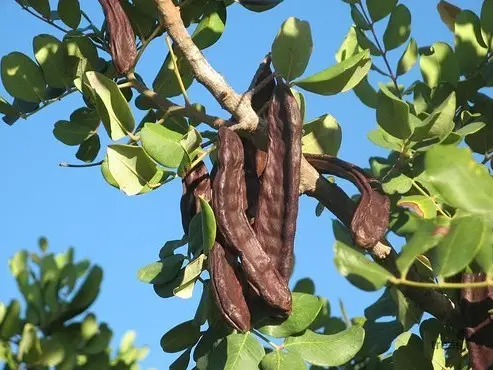
It is an evergreen tree native to Mediterranean regions with elongated seed pots that grow up to 12 inches (30cm) in length. The pods contain edible pulp used as a substitute for chocolate.
The tree can grow up to 50ft (15m) with evergreen foliage throughout the year. The dark green leathery leaves have a pinnate shape that contributes to its aesthetic appeal.
Carob trees are well-adapted to USDA hardiness zones 9 to 11. These trees are resilient and can tolerate drought conditions without compromising their health.
Scientific Name |
Ceratonia siliqua |
Origin |
Mediterranean regions |
Bark Appearance |
Dark brown and rough |
Maximum Height |
50ft |
USDA Zone |
9-11 |
Purple Orchid Tree (Bauhinia variegata)
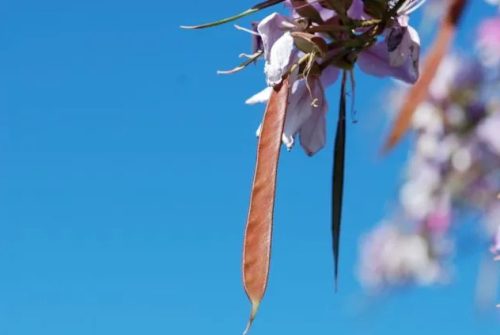
It is a captivating flowering tree native to Southeast Asia. It is prized for its stunning and vibrant purple flowers that resemble orchids.
The long seed pods can reach 12 inches (30cm) and add an interesting visual element to the tree. These long seed pods hang down among the leaves.
You can collect the numerous seeds for propagation or leave them to disperse naturally. The large butterfly wing-like leaves have two lobes that give them a unique appearance.
The purple orchid tree can grow up to 20-40ft (6-12cm) at maturity. The round spreading canopy provides ample shade beneath its branches. It is best suited for USDA hardiness zones of 9-11.
Scientific Name |
Bauhinia variegata |
Origin |
Southeast Asia |
Bark Appearance |
outerside is grey with pale-pink inside |
Maximum Height |
20-40ft |
USDA Zone |
9-11 |
Amur Maackia (Maackia amurensis)
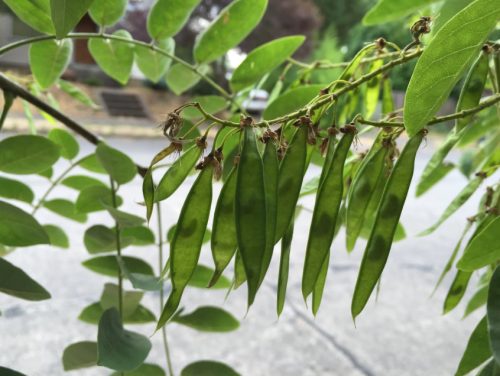
This is a deciduous tree native to eastern Asia (Russia and northeastern China). It is widely cultivated for its ornamental value and ability to withstand harsh climates.
The long seed pods are distinctive features and can grow up to 4-6 inches (10-15 cm) in length. The pods add visual appeal to the trees in the autumn since they turn reddish-brown.
The pinnate leaves have several leaflets arranged in pairs along a central axis. The dark green leaves provide a lush canopy during the summer.
The Amur Maackia can grow up to 30 -50 feet (9 -15 meters) with a spread of 20-30 feet (6-9 meters). Its growth rate is considered moderate, making it suitable for medium-sized gardens and landscapes.
These trees are well-suited for hardiness zones of 3-7. They can also tolerate cold temperatures and are ideal for landscaping projects.
Scientific Name |
Maackia amurensis |
Origin |
Eastern Asia |
Bark Appearance |
Amber with peeling texture and green undertones |
Maximum Height |
30-50ft |
USDA Zone |
3-7 |
Yellow Bells (Tecoma stans)
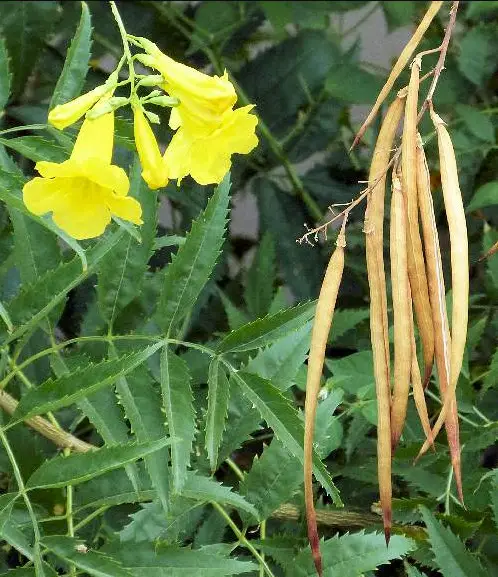
This is a flowering plant native to the Americas. The shrub has vibrant yellow trumpet-shaped flowers that help to attract pollinators in your backyard garden.
The elongated seed pods are distinctive features and can grow up to 12 inches (30cm) long. These long seed pods add visual interest to the tree.
The pinnate leaves have leaflets arranged in pairs along the central stem. The elongated leaflets have glossy green color that provides an attractive backdrop for the bright yellow flowers.
The small to medium size tree or shrub has an average height of 10-15ft (3-4.5 m). But the size can vary since it depends on the growing conditions and pruning practices.
Yellow bells trees are best suited for warm regions with USDA hardiness zones 8-11. We recommend growing yellow bells in containers in colder regions.
Scientific Name |
Tecoma stans |
Origin |
Americas |
Bark Appearance |
Light brown to pale grey |
Maximum Height |
10-15ft |
USDA Zone |
8-11 |
Trumpet Trees (Tabebuia)
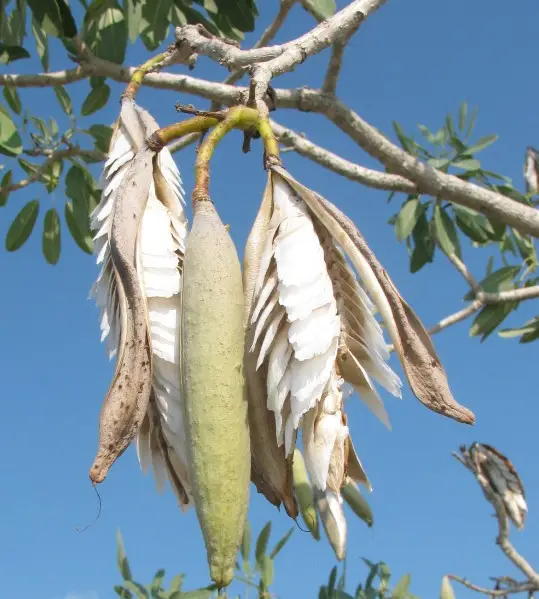
These are flowering trees native to tropical and subtropical regions of Central and South America. These trees are admired for their vibrant trumpet-shaped blossoms and are commonly cultivated for their ornamental value.
The long seed pods hang from the branches and contain numerous small seeds that are dispersed by wind or animals. These pods add visual interest to the tree, even after the blooms have faded.
The leaves have a feathery appearance and are composed of elongated, lance-shaped leaflets. This foliage provides an attractive backdrop to the colorful flowers, enhancing the overall beauty of the tree.
Trumpet Trees can grow up to 25-40 feet (7.6 -12 meters) But some species can reach greater heights. They have an upright and symmetrical growth habit, forming a well-defined canopy.
These trees thrive in USDA hardiness zones 9 to 11. These zones encompass regions with mild to warm climates, where temperatures rarely drop below freezing.
Scientific Name |
Tabebuia |
Origin |
Central and South America |
Bark Appearance |
gray to brown |
Maximum Height |
25-40ft |
USDA Zone |
9-11 |
Desert Willow (Chilopsis linearis)
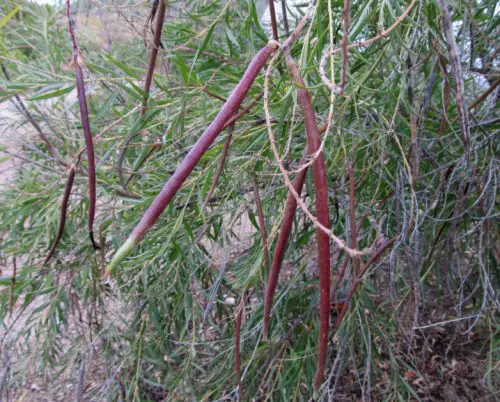
It is a native tree species with a graceful appearance and adaptability to arid environments. It belongs to the family Bignoniaceae and is commonly found in the southwestern United States and northern Mexico.
The desert willow tree has long seed pods that grow up to 10 inches in length. These pods are slender and typically hang from the tree branches to add visual interest to the landscape.
The narrow and elongated leaves resemble those of willow trees. The green leaves offer a delicate appearance. But the tree usually sheds the leaves in winter and reveals its attractive branching structure.
The tree has an average height of 15-30ft (4.5-9 m). But the height depends on the growing conditions and pruning practices. It thrives in USDA hardiness zones 7-9.
Scientific Name |
Chilopsis linearis |
Origin |
Southwestern United States and Northern Mexico |
Bark Appearance |
Dark brown |
Maximum Height |
15-30ft |
USDA Zone |
7-9 |
Acacia Tree (Acacia)
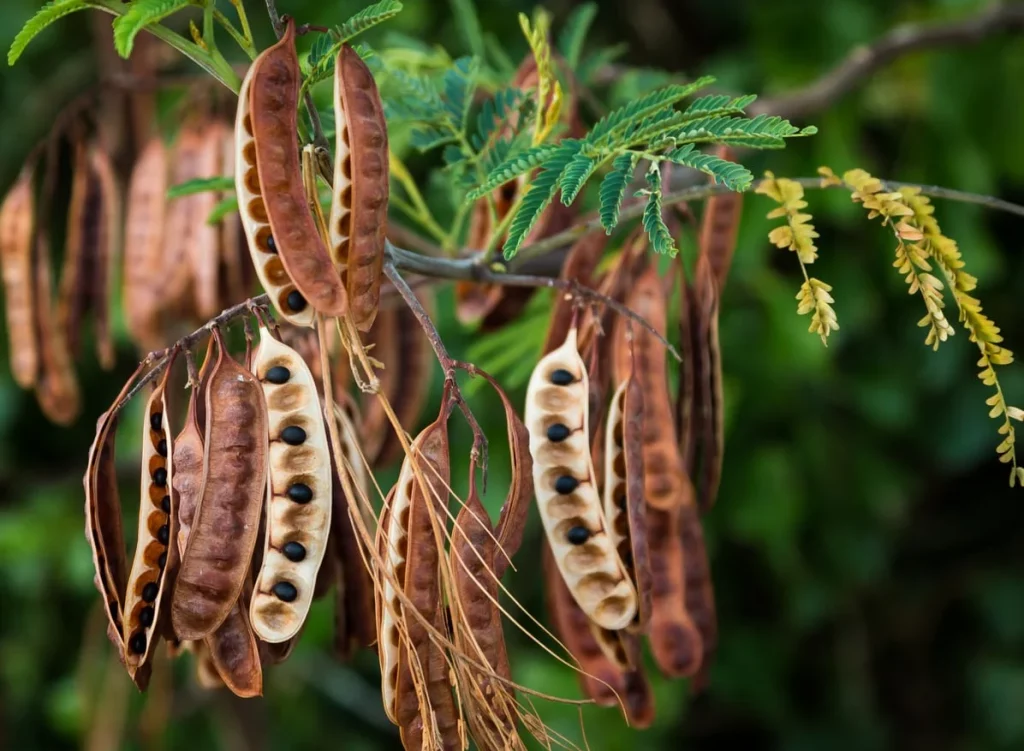
This fascinating tree species is Native to Africa, Australia, and America since it thrives in diverse environments and has adapted to different climates.
The long seed pods have prominent characteristics and grow to considerable lengths. They often have a twisted or coiled appearance and contain numerous seeds.
The leaves of the Acacia tree are small, and feathery with multiple small leaflets arranged along a central stalk. The leaflets are usually elongated and provide a delicate appearance to the tree.
Acacia trees range from small shrubs to tall trees depending on the species. Some Acacia varieties are relatively smaller and may grow up to 20-30 feet in height.
The USDA zones 9-11 are suitable for Acacia trees since they thrive in warmer climates. Some varieties may tolerate cooler temperatures and can be grown in zones as low as 7 or 8.
Scientific Name |
Acacia |
Origin |
Africa, Australia, and America |
Bark Appearance |
Gray to brown |
Maximum Height |
20-30ft |
USDA Zone |
7-8 |
Kentucky Coffee Tree (Gymnocladus dioicus)
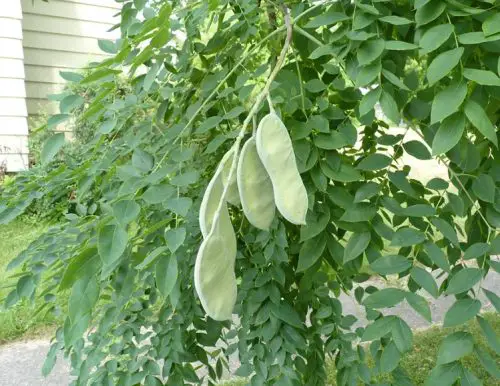
It is a large deciduous tree native to North America and belongs to the Fabaceae family. The seed pods of the Kentucky Coffee Tree are long, flat, and leathery. They have a dark brown color and a distinct twist or curl. The pods contain small, hard-coated seeds.
The seed pods can reach lengths of 5 to 10 inches (12 to 25 cm). The tree can grow up to 60-100 feet (18-30 meters) tall. It can also spread to 40 to 70 feet (12 to 21 meters). The tree has a broad, rounded shape.
These trees are adaptable to a wide range of climates and can thrive in USDA Zones 3 to 8. An ultimate running routine will help to control its height and canopy spread.
Scientific Name |
Gymnocladus dioicus |
Origin |
North America |
Bark Appearance |
Dark brown |
Maximum Height |
60-100ft |
USDA Zone |
3-8 |
Royal Poinciana Tree (Delonix regia)
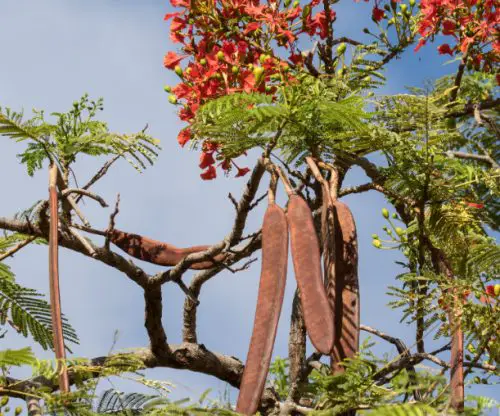
It is a large flowering tree native to Madagascar and belongs to the Fabaceae family. The seed pods are long, flat, and woody. They have a dark brown color and contain numerous small, flat seeds.
Royal Poinciana tree seed pods can grow up to 2 feet (60 cm) in length. The tree can attain 30 to 40 feet (9 to 12 meters) with a canopy spread of 40 to 60 feet (12 to 18 meters).
The wide and umbrella-like shape canopy is an impressive feature.Royal Poinciana Trees thrive in tropical and subtropical regions and are suitable for USDA Zones 10 to 12.
Scientific Name |
Delonix regia |
Origin |
Madagascar |
Bark Appearance |
Grey |
Maximum Height |
40-60ft |
USDA Zone |
10-12 |
Palo Verde Tree (Parkinsonia florida)
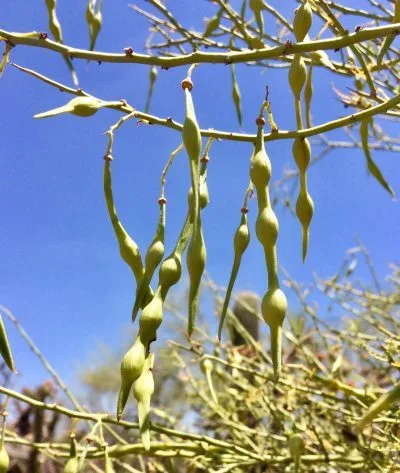
It is a small deciduous tree native to the southwestern United States and northern Mexico. It also belongs to the Fabaceae family.
The seed pods of the Palo Verde Tree are long, slender, and slightly curved. They start green and mature to a brown color. The pods contain small and rounded seeds.
The seed pods range from 3 to 6 inches (7 to 15 cm) in length. The tree can grow up to 15-30 feet (4.5-9m) high under favorable growing conditions.
The canopy of a mature Palo Verde Tree can spread to 20 to 30 feet (6 to 9 meters). These trees thrive in arid and semi-arid regions and are suitable for USDA Zones 8 to 11.
Scientific Name |
Parkinsonia florida |
Origin |
Southwestern USA and Northern Mexico |
Bark Appearance |
Blue-green |
Maximum Height |
15-30ft |
USDA Zone |
8-11 |
Cape Wattle (Paraserianthes lophantha)
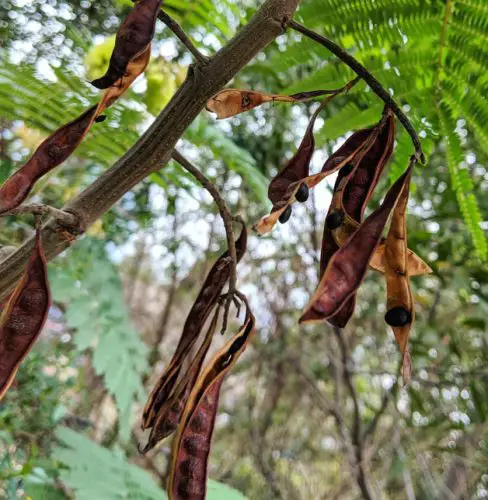
It is an evergreen tree native to Australia and belongs to the Fabaceae family. The seed pods are long, slender, and cylindrical. They start green and mature to a dark brown color. The pods hold small, oval-shaped seeds.
Cape Wattle seed pods can reach lengths of 4 to 6 inches (10 to 15 cm) and the tree can grow up to 30-40 feet (9-12m) high.
The canopy of a mature Cape Wattle tree can spread to 20 to 30 feet (6 to 9 meters). These trees are well-suited to warm and temperate regions and can thrive in USDA Zones 9 to 11.
Scientific Name |
Paraserianthes lophantha |
Origin |
Australia |
Bark Appearance |
smooth and light |
Maximum Height |
30-40ft |
USDA Zone |
9-11 |
Mimosa Tree (Albizia julibrissin)
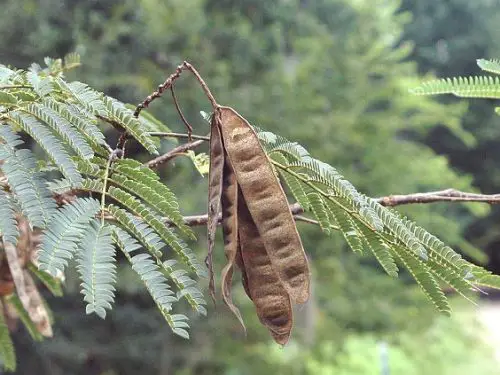
It is a small deciduous tree native to Asia and belongs to the Fabaceae family. The tree seed pods are long, flat, and reddish-brown in color. They contain small, rounded seeds and exhibit a characteristic spiral twist.
Mimosa Tree seed pods can reach lengths of 4 to 8 inches (10 to 20 cm). The tree can grow up to 20-40 feet (6-12 m) high in a favorable growing conditions.
A mature tree canopy can spread to 30- 40 feet (9-12 meters). Mimosa Trees are adaptable to various climates and can thrive in USDA Zones 6 to 9.
Scientific Name |
Albizia julibrissin |
Origin |
Asia |
Bark Appearance |
Dark grey |
Maximum Height |
20-40ft |
USDA Zone |
6-9 |
Judas Tree (Cercis siliquastrum)
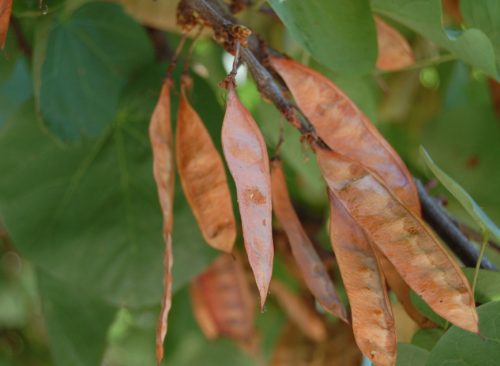
It is a deciduous tree native to the Mediterranean region and belongs to the Fabaceae family. The seed pods are long, flat, and brown in color.
These seed pods contain small and round seeds with a conspicuous waist in the middle. Each seed pod can grow up to 6 inches (15cm) in length.
A mature tree can reach 20-30 feet (6-9m) with a canopy spread of 15-25 feet (4.5-7.5m). Judas Trees thrive in Mediterranean climates and are suitable for USDA Zones 7 to 9.
Scientific Name |
Cercis siliquastrum |
Origin |
Mediterranean region |
Bark Appearance |
Dark gray |
Maximum Height |
20-30ft |
USDA Zone |
7-9 |
Eastern Redbud Tree (Cercis canadensis)
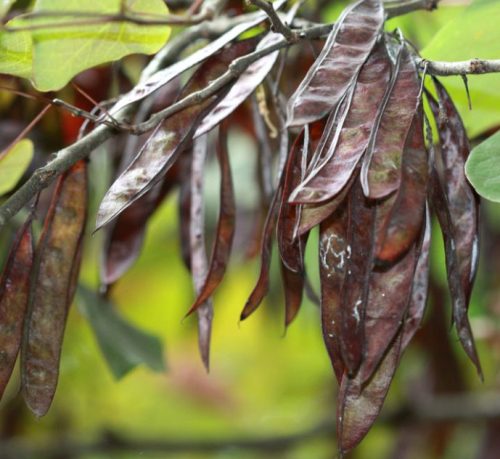
It is a small deciduous tree native to eastern North America and belongs to the Fabaceae family. The tree seed pods are long, flat, and leathery.
These long brown seed pods develop from pink or purple flowers in spring. They contain small and round seeds for propagation.
The seed pods can reach 2-4 inches (5-10 cm). A mature tree can grow up to 20-30 feet (6-9 m) high with a canopy spread of 25-35 feet (7.5-10.5 m).
Eastern Redbud Trees are adaptable and can thrive in a variety of climates. The most suitable USDA Zones are 4 to 9. These trees are not suitable for planting near buildings or houses.
Scientific Name |
Cercis canadensis |
Origin |
Eastern North America |
Bark Appearance |
Dark brown to black with orange inner bark |
Maximum Height |
20-30ft |
USDA Zone |
4-9 |
Black Locust Tree (Robinia pseudoacacia)
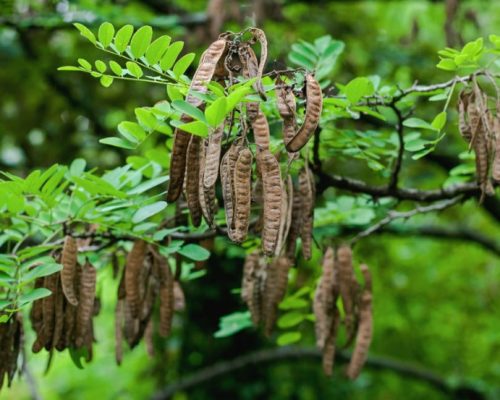
It is a deciduous tree native to the southeastern United States. The tree seed pods are long, flat, and brown with small flat seeds that can tolerate winter conditions.
These seed pods are covered in sharp thorns and can grow up to 6 inches (15cm) long. A mature black locust tree can grow up to 30-50 feet (9-15m).
The canopy of a mature Black Locust Tree can spread to 20 to 30 feet (6 to 9 meters). These trees are hardy and adaptable, suitable for USDA Zones 3 to 9.
Scientific Name |
Robinia pseudoacacia |
Origin |
Southeastern United States |
Bark Appearance |
reddish black and grey with tinged red or orange in grooves |
Maximum Height |
30-50ft |
USDA Zone |
3-9 |
Honey Locust Tree (Gleditsia triacanthos)
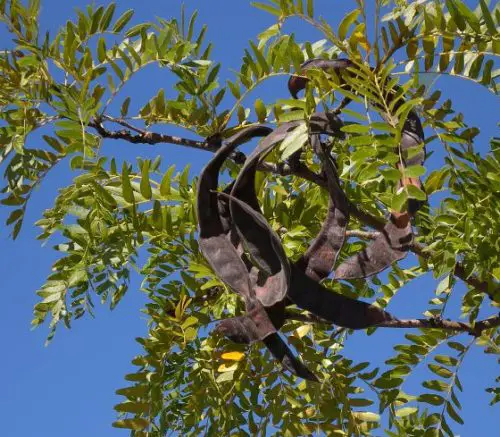
It is a deciduous tree native to North America and belongs to the Fabaceae family. The long twisted seed pods are brown in color.
These seed pods contain small oval-shaped seeds covered in sharp thorns. Each seed pod can grow up to 6 inches (15cm) long.
A mature tree can reach a height of 30-70 feet (9-21 m) with a canopy spread of 30-50 feet (9-15 m). These trees are adaptable and can thrive in various climates, suitable for USDA Zones 3 to 9.
Scientific Name |
Gleditsia triacanthos |
Origin |
North America |
Bark Appearance |
gray-brown |
Maximum Height |
30-70ft |
USDA Zone |
3-9 |
Southern Catalpa (Catalpa bignonioides)
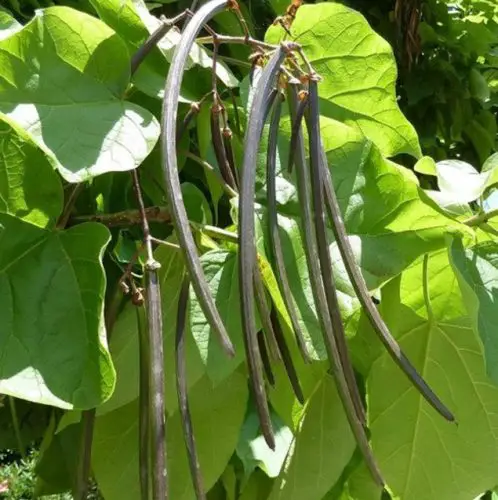
It is a deciduous tree native to the southeastern United States and belongs to the Bignoniaceae family. The seed pods are long, cylindrical, and start green, maturing to a brown color.
These long seed pods contain numerous small flat seeds. Each seed pod measures about 6-20 inches (15-50 cm) long. A mature tree can grow up to 40-60 feet (12-18m) high.
The canopy of a mature Southern Catalpa tree can spread to 30 to 40 feet (9 to 12 meters). These trees thrive in warm climates and are suitable for USDA Zones 5 to 9.
Scientific Name |
Catalpa bignonioides |
Origin |
southeastern United States |
Bark Appearance |
flaky and grey |
Maximum Height |
40-60ft |
USDA Zone |
5-9 |
Northern Catalpa (Catalpa speciosa)
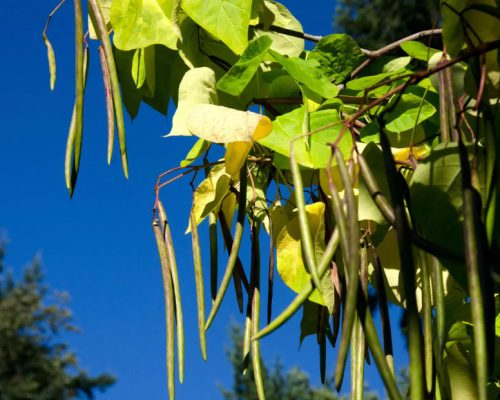
It is a deciduous tree native to the central United States and belongs to the Bignoniaceae family. The long cylindrical-shaped seed pods start green and then turn brown after maturing.
These seed pods contain numerous small flat seeds. Northern Catalpa seed pods can reach 8 to 20 inches (20 to 50 cm).
These trees can reach a height of 40-70 feet (12-21 m) with a canopy spread of 20-40 inches (6-12m). These trees thrive in a variety of climates and are suitable for USDA Zones 4 to 8.
Scientific Name |
Catalpa speciosa |
Origin |
North America |
Bark Appearance |
flaky and grey |
Maximum Height |
40-70ft |
USDA Zone |
4-8 |
Catalpa Trees (Catalpa)
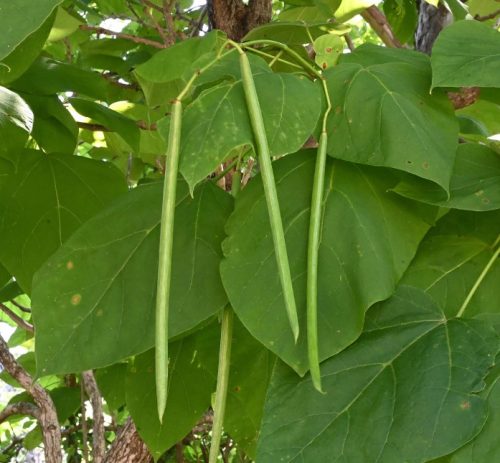
It is a deciduous tree known for its impressive flowers and large seed pods. The long cylindrical seed pods contain small flat seeds and vary in appearance depending on the tree species.
These long seed pods measure about 6-20 inches (15-50 cm) long. Some catalpa tree species might have longer seed pods than others.
A mature Southern Catalpa exhibits a height of 40-60 feet (12-18 meters). Some tree species can grow up to 40-70 feet (12 -21 meters) with a canopy spread of 20-40 feet (6 -12 meters).
These trees are known for providing ample shade and coverage. Depending on the species and variety, these trees can thrive in USDA Zones 4 to 9.
Scientific Name |
catalpa |
Origin |
West Indies, Eastern North America, and Eastern Asia |
Bark Appearance |
flaky and gray |
Maximum Height |
40-70ft |
USDA Zone |
4-9 |
Final Thoughts From Experts
Different types of trees with long seed pods are fascinating and important members of our natural environment. These trees produce elongated pods that serve as protective containers for their seeds. The length of these pods varies across different tree species, with some reaching impressive sizes.
These seedpods play a crucial role in dispersing seeds and ensuring the survival and propagation of these tree species. Understanding the characteristics and significance of trees with long seed pods enhances our appreciation for the diverse and remarkable adaptations found in the plant kingdom.
People Who Read This Also Read:






